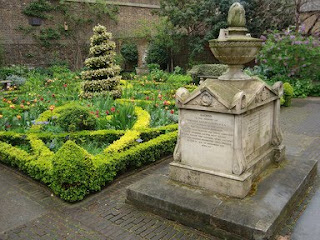From Kristine: As you read this, Victoria will have arrived in London and I’ll be heading for New York in order to rendezvous with my daughter before our flight out to Heathrow late tomorrow night. There will be just a few changes to the blog while we’re away, one being that the blog may look a bit different since we won’t be able to shorten up the previous day’s posts as consistently as we do now. Also, while we’re away we’ve scheduled posts to run every other day, instead of every day as usual. Of course, we’ll also be randomly logging in via internet cafes to report on our progress and doings during our trip. Really, I don’t know what I’ll do without blogging everyday . . . . . .

We’ve made a few adjustments to our itinerary. For instance, we are now having dinner at the Grenadier Pub on Sunday evening and are going to be joined by Carrie Bebris, author of the Mr. and Mrs. Darcy mystery series. Carrie is doing some last minute research on her next book, which will be based on the characters from Jane Austen’s Persuasion, and we are eager to hear about her visit to Lyme Regis, below.

From Victoria: Carrie now lives in Ohio, but we are long-time friends from her days in Wisconsin where we collaborated on projects for the Wisconsin Romance Writers and the Jane Austen Society Wisconsin branch. We were roommates last October in Philadelphia at the JASNA-AGM.
Above is the French translation of Carrie’s book Intrigue at Highbury. After her dalliance in France, Kristine might try to read this version. How about it, Kristine????
Our dinner will be at the Grenadier Pub. We hope we get in a lot of chatting before the ghosts arrive to divert us. You can read Kristine’s account of her previous visit to the Pub
here.

We’ll also be meeting author/actor Ian Kelly at the London Library, where he’s been working on his next project, the bio of, as Ian told us, “another Georgian bad boy.” We’ll then be going on to tea together, so you can bet we’ll be trying to pin Ian down on the subject of his next book. If we’re not sworn to secrecy, we’ll tell you all about it.

If all goes according to Plan, I will have completed two days in London by now, the first spent at the British Library and the second spent at the Hertfordshire Archives in Hertford, a short train ride north of the City. I have reserved materials at both places and at the National Art Library at the
Victoria and Albert Museum, left.

Among the other wonderful places Kristine and I intend to drop by is
Hatchards Bookstore, in place at 187 Piccadilly since 1797. Just breathing the air here is a delight. Not to mention the many antiquarian book shops and print sellers we will haunt. We promise to share all the details with you eventually.

Here’s a picture I took of a display window in Fortnum and Mason, nearby on Piccadilly in May 2009 when my husband and I were staying just half a block away at the Cavendish Hotel, corner of Jermyn and Duke Streets. Though the Cavendish is a high rise hotel, it sits on the site of the 19th Century hotel run by Rosa Lewis. She is famous as the fictionalized Louisa Trotter (played by Gemma Jones) in the BBC-PBS series
The Duchess of Duke Street, one of my favorites from Masterpiece Theatre. Below is the statue of Beau Brummell, fashion arbiter, which stands near the Cavendish on Jermyn Street, home of many gentleman’s haberdasheries.

Below, another sculpture on the pavement, this one of FDR and Sir Winston Churchill having a conversation on Bond Street. It was unveiled in 1995 by Princess Margaret; the sculptor is Lawrence Holofcener. The statue commemorates 50 years of peace since WWII ended. (Well, shall we say, relative peace?) Note the shiny arms and knees on the inside halves of the figures — the result of so many people sitting between the two leaders to have their picture taken. This was one of the intentions of the sculpture and it has worked a treat.
Both Kristine and I are eager to find all sorts of new experiences as well as to savor again some of our old favorites. Bon Voyage indeed!



















